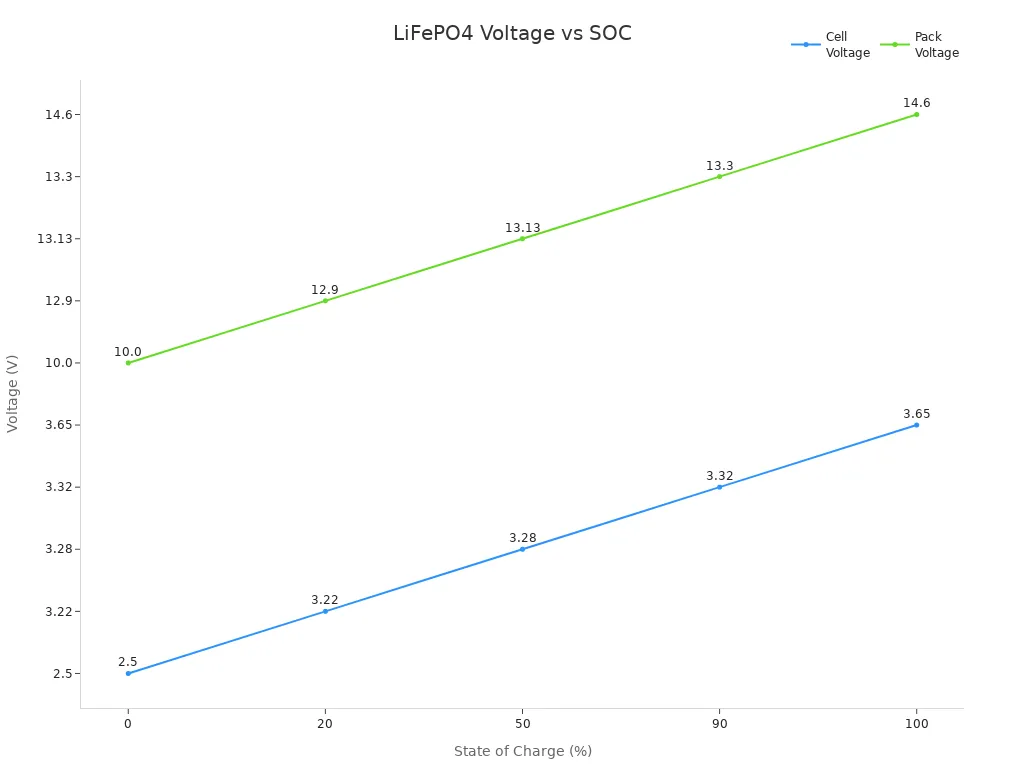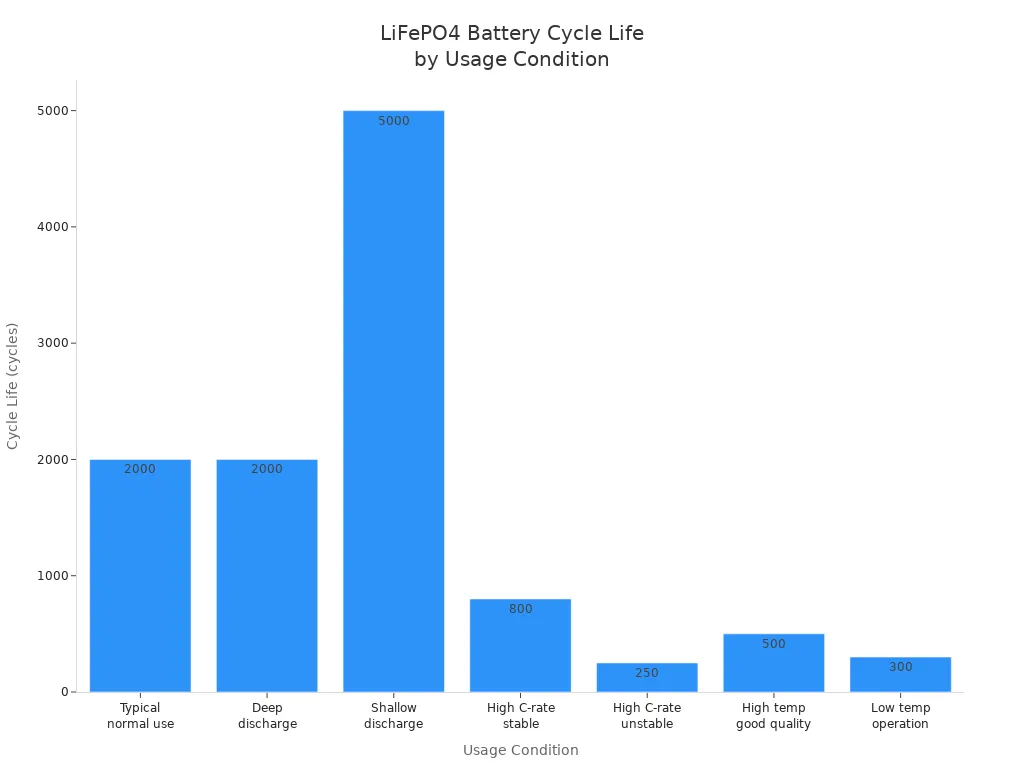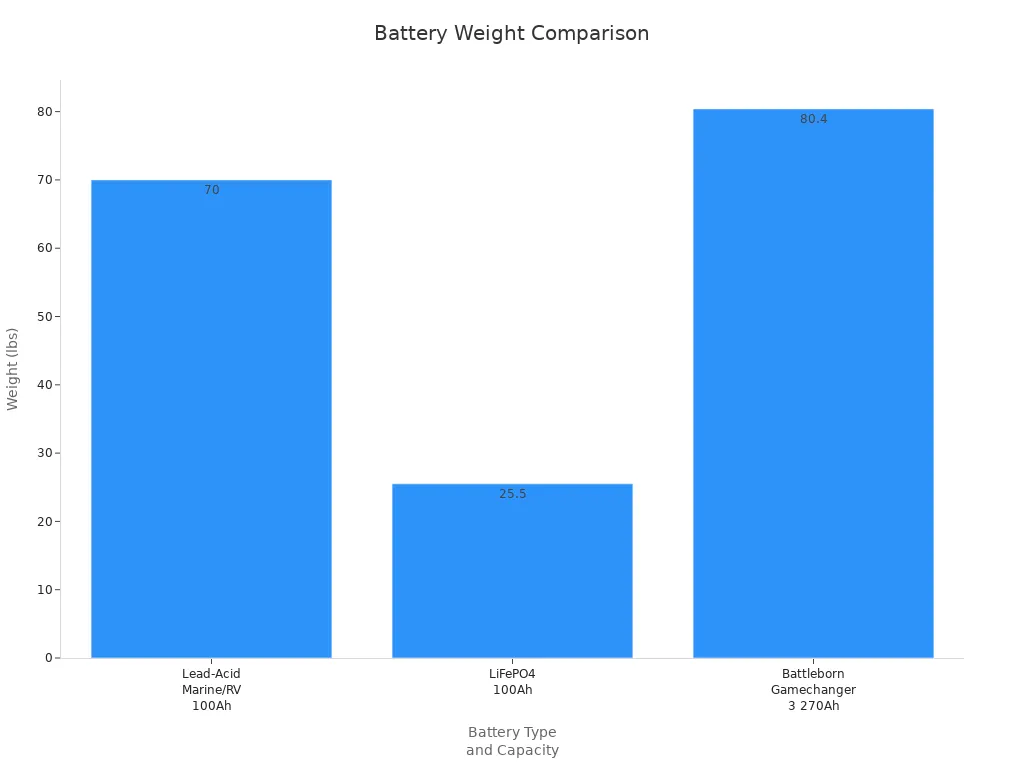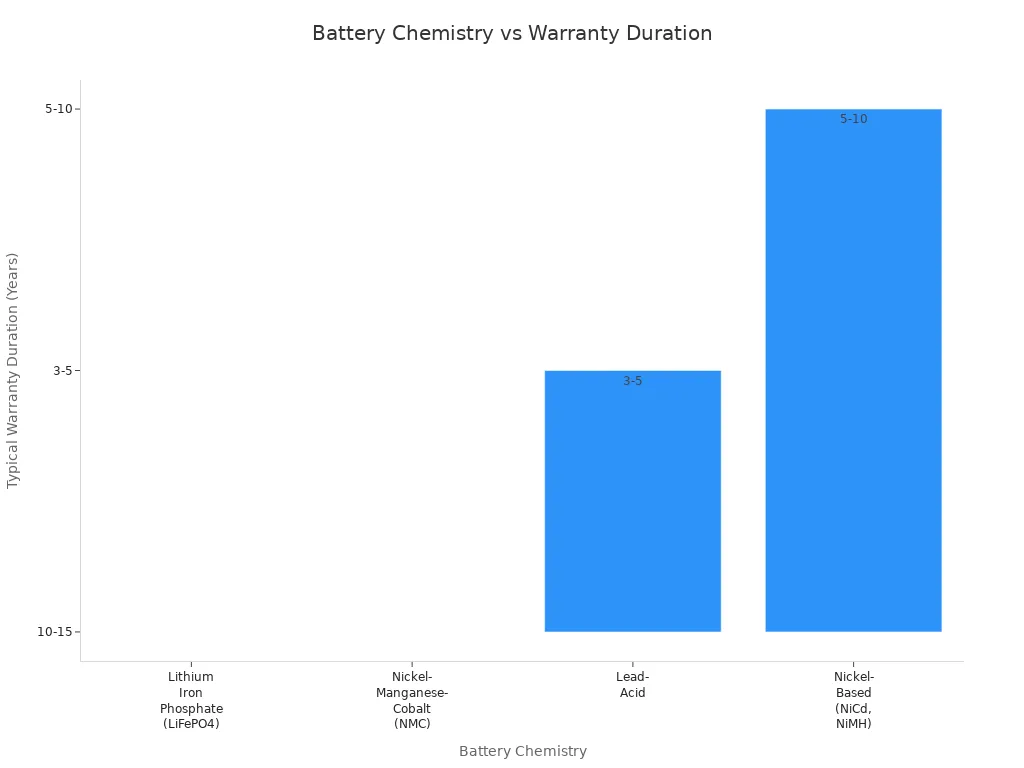







A lithium iron phosphate battery, also called a LiFePO4 battery, gives steady and reliable power for many things. It uses lithium iron phosphate as its main material, which makes it different from other batteries. This battery is used in almost 30% of rechargeable batteries around the world. People pick LiFePO4 batteries because they are very safe and last a long time.
When you think about safety, LiFePO4 is special:
It does not catch fire as easily as other lithium batteries.
It does not let out oxygen if it fails, so fires do not keep burning.
You still need to be careful, because all batteries have some risk.
You use a lithium iron phosphate battery for new energy needs, like solar power, RVs, or backup power, because it is safer and lasts longer.
LiFePO4 batteries are very safe and stable. They lower fire risks compared to other lithium batteries. They last a long time and can reach up to 10,000 charge cycles. This helps save money because you do not need to replace them often. Use chargers made for LiFePO4 batteries. Do not charge them fully or let them run out completely. This keeps the battery healthy. These batteries work well for solar power, RVs, backup power, and electric vehicles. They are reliable. They cost more at first and are heavier. But their safety, long life, and low maintenance make them a smart choice.

You use a LiFePO4 battery for safe energy storage. This battery is also called an LFP battery. It uses lithium iron phosphate as its main chemical. It is different from other lithium-ion batteries. It gives better thermal and chemical stability. You can trust it to stay cool, even with fast charging. It does not catch fire easily, so you feel safer.
A lithium iron phosphate battery has a special crystal structure. Lithium ions move in a zigzag path through channels. Iron atoms sit inside shapes made of six oxygen atoms. Phosphate groups form units with four corners. These parts connect to make a strong 3D frame. When you use the battery, lithium ions travel through these channels. This movement lets the battery store and release energy safely.
Tip: A lithium iron phosphate battery can last up to 10,000 cycles. This is much longer than most other lithium-ion batteries. Most others last only 500 to 1,000 cycles. You get more value and worry less about replacing it.
You help the environment by choosing an LFP battery. It does not have toxic metals, so it is safer to throw away. You can use it for solar systems, RVs, and backup power. It fits many modern energy storage needs.
Key points about lithium iron phosphate chemistry:
It has an olivine-type crystal structure.
Iron atoms sit in FeO6 octahedra.
Phosphate groups form PO4 tetrahedra.
Lithium ions move through one-dimensional channels.
The structure stays stable after many charges.
Every LFP battery has several important parts. Each part helps make the battery safe and strong.
Cathode: The cathode uses lithium iron phosphate. This gives the battery its name and safety. It holds lithium ions when charged.
Anode: The anode uses graphite. It stores lithium ions when the battery is used. Graphite is good because it conducts electricity and stays stable.
Electrolyte: The electrolyte lets lithium ions move between the cathode and anode. It helps the battery charge and discharge well.
Separator: The separator keeps the cathode and anode apart. It stops short circuits and keeps the battery safe.
Battery Management System (BMS): The BMS is like the brain of the battery. It checks voltage, current, and temperature. It stops charging if the battery is too full. It cuts power if the battery is too empty. It balances the cells to keep them healthy. It protects against short circuits and overheating. The BMS helps the battery last longer and work safely.
Main functions of the BMS:
Watches voltage, current, and temperature.
Stops overcharging and over-discharging.
Protects against short circuits.
Balances cells for longer life.
Shows state of charge and health.
You can see the usual voltages and charging ranges for LFP batteries in this table:
Pack Voltage | Bulk Charging Voltage | Float Voltage | Equalize Voltage |
|---|---|---|---|
3.2V (cell) | 3.65V | 3.375V | 3.65V |
12V | 14.6V | 13.5V | 14.6V |
24V | 29.2V | 27.0V | 29.2V |
48V | 58.4V | 54.0V | 58.4V |
You can also see how voltage changes as the battery charges or discharges:

A normal LFP battery cell gives 3.2V. You can charge it up to 3.65V and use it down to 2.5V. Many LFP batteries have a battery capacity of 100Ah. This means they can store a lot of energy for your needs.
You get a strong, safe, and long-lasting energy storage solution with a lithium iron phosphate battery. It works well for solar, RV, and backup power. You can count on it for steady performance and easy care.
You may wonder how a lithium iron phosphate battery works. The answer is in its special chemistry. When you charge the battery, lithium ions move from the cathode. The cathode is made of lithium iron phosphate. The ions travel through the electrolyte and separator. They go into the graphite anode. At the same time, electrons move outside the battery. They go from the cathode to the anode. This stores energy inside the battery.
When you use the battery, the steps switch. Lithium ions leave the graphite anode. They travel back to the cathode. Electrons flow through your device. This gives your device power. The lithium iron phosphate structure takes the ions back. This keeps the battery safe and stable.
Here is a simple table that shows what happens during charging and discharging:
Process | Electrode | Electrochemical Reaction |
|---|---|---|
Charging | Cathode | LiFePO₄ → Li⁺ + FePO₄ + e⁻ |
Charging | Anode | xC + Li⁺ + e⁻ → LiCₓ |
Discharging | Cathode | LiFePO₄ + e⁻ ↔ Li⁺ + FePO₄ |
Discharging | Anode | LiCₓ → xC + Li⁺ + e⁻ |
You get a safe battery because the lithium iron phosphate cathode is strong. The bonds between iron, phosphorus, and oxygen are tight. These bonds make the battery stable. Even if you overcharge or drop it, the battery stays safe. The structure does not break down easily. It does not catch fire or explode like some other batteries. This makes lithium iron phosphate batteries great for electric vehicles and solar systems.
Note: The strong structure of the LFP battery means you can trust it. It stays cool and safe, even after long use.
Charging and discharging are the main things you do with any battery. The LFP battery is special because it does these things safely. It also lasts a long time. When you charge the battery, lithium ions move into the graphite anode. When you use the battery, the ions go back to the cathode. This back-and-forth movement gives you steady power.
To get the best life and performance from your LFP battery, follow some easy rules:
Use a charger made for LFP batteries. Regular chargers for lead-acid batteries do not work well.
Charge using the CC/CV method. Start with constant current until the battery reaches its top voltage. Then switch to constant voltage until it is full.
Do not charge to 100% every time. Charging to 80-90% helps your battery last longer.
Keep the battery between 0°C and 45°C when charging. High or low temperatures can hurt the battery.
Avoid deep discharges. Try to recharge when the battery drops to 20-30%.
Store the battery at 50-70% charge if you will not use it for a while.
The battery management system (BMS) helps keep your LFP battery safe. It checks the voltage, current, and temperature. If the battery gets too full, the BMS stops charging. If the battery gets too empty, the BMS stops discharging. The BMS also balances the cells inside the battery. This makes sure each cell works its best. This protection keeps your battery safe and helps it last longer.
The BMS:
Stops overcharging and deep discharging.
Balances cells for even performance.
Monitors temperature and voltage.
Cuts off power if something goes wrong.
Tip: Always use a battery with a built-in BMS. It protects your battery and gives you peace of mind.
You can expect a long cycle life from your lithium iron phosphate battery. Most LFP batteries last for 2,000 to 5,000 cycles before losing power. If you avoid deep discharges and overcharging, your battery can last even longer. Some last up to 10,000 cycles. This means you can use your LFP battery every day for many years.

You get steady power, long life, and safety with a lithium iron phosphate battery. The LFP battery gives you reliable power for solar, RV, or backup needs. You can count on it to work well and keep you safe.
There are many good things about using an LFP battery. The biggest reason people choose LFP is safety. This battery has a strong structure. It does not get hot, catch fire, or leak easily. You can use it at home or in your RV and feel safe. It will not explode or burn like some other batteries. The LFP battery stays cool, even after many charges or uses.
Key safety features of LFP batteries:
Strong build keeps it from getting too hot.
Phosphate chemistry helps stop fires.
It does not leak and is not toxic.
No cobalt means it is better for the earth.
An LFP battery also lasts a long time. It can work for thousands of cycles. You can use it every day for many years. It does not lose much power as it gets older. You do not have to replace it often. You can use more of its energy than a lead-acid battery. This gives you more power to use.
Other advantages:
Needs little care. You do not have to add water or clean it.
Gives steady power. The LFP battery keeps voltage and current even.
Works well in hot or cold. It runs from -20°C to 60°C.
Good for the environment. It uses safe materials and is easy to recycle.
Feature | LiFePO4 Battery | Lead-Acid Battery |
|---|---|---|
Cycle Life | Several thousand | A few hundred |
Depth of Discharge | Up to 80-90% | About 50% |
Safety | Very high | Lower |
Maintenance | Low | High |
Environmental Impact | Low | Higher |
Tip: LiFePO4 batteries last a long time and are very safe. They are a smart pick for solar, RV, and backup power.
You should know the downsides of LFP batteries before buying. The first problem is size and weight. LFP batteries do not hold as much energy for their size. They are bigger and heavier than other lithium-ion batteries. If you need a small or light battery, this could be a problem.
You also pay more at the start. LFP batteries cost more than lead-acid or some other lithium-ion batteries. You spend more money at first, but you save later because they last longer.
Common disadvantages:
They hold less energy for their size.
They cost more to buy at first.
They charge slower than some other batteries.
Some LFP batteries cannot give a lot of power quickly.
They do not work as well in very hot or cold weather.
They are not as easy to find as other batteries.
Battery Type | Initial Cost (15kWh) | Notes |
|---|---|---|
LiFePO4 (LFP) | $2,500 – $4,000 | Baseline, longer lifespan |
NMC Lithium-ion | $2,200 – $3,500 | Cheaper, may need cooling |
Lead-Acid | Lowest | Short lifespan, low cost |
Note: LiFePO4 batteries cost more at first, but you save money over time.
You must use a charger made for LFP batteries. Regular chargers might not work right. Some devices do not support LFP batteries yet. Always check if your device works with LFP before you buy.
You can use LFP batteries for home energy storage. These batteries work great with solar power systems. They keep extra energy from your solar panels during the day. At night or if the power goes out, you use this stored energy. It can run your lights, appliances, or even charge your electric car. Many people pick LFP batteries for backup power. They last a long time and are safe, even with daily use.
LiFePO4 batteries help you save money on bills. You can charge them when electricity is cheaper. Later, you use the stored energy when prices are higher. This is called peak shaving. It helps lower your electricity costs.
LiFePO4 batteries are good for home storage because they last long and need little care. They do not get hot or catch fire easily. You can trust them to keep your home safe. They also support important things, like medical equipment. You always have power when you need it.
Application | Benefit |
|---|---|
Solar plus storage | Use solar energy at night |
Backup power | Keep lights and appliances on |
Peak shaving | Lower electricity costs |
LiFePO4 batteries work better than lead-acid batteries for energy storage. They last longer and work well in hot or cold weather. You get more energy you can use. They give you a reliable way to store energy at home.
LiFePO4 batteries are great for mobile energy storage. You can use them in your RV, boat, or electric vehicle. They power motors, lights, fridges, and more. LFP batteries handle bumps, shakes, and changes in temperature. You get steady power, even in rough places.
These batteries are light and easy to carry. You can take them on trips or camping. LFP batteries store solar energy from panels on your RV or boat. You stay powered up, even far from the city.
Many LFP batteries come with long warranties. Some brands give up to 12 years of coverage. You can feel safe about your investment.
LFP batteries need almost no care. They do not leak or use harmful metals. You help the earth by choosing them. They also work well for electric vehicles, giving safe and steady energy on the road or water.
Main LFP energy storage uses for mobility:
RV house batteries
Marine motors and appliances
Mobility scooters and electric vehicles
Off-grid backup power
You get a strong, portable, and safe energy system with LFP batteries. They fit many needs, from home storage to electric vehicles.
You might wonder how an LFP battery compares to other lithium-ion batteries. The main difference is the chemistry inside each battery. LFP batteries use lithium iron phosphate. Other types use nickel manganese cobalt or lithium cobalt oxide. This difference changes how safe the battery is, how long it lasts, and how much energy it can hold.
LFP batteries are known for being very safe. The strong bonds in the lithium iron phosphate cathode keep the battery stable. You do not have to worry about fire or overheating, even if the battery gets damaged. Other lithium-ion batteries can get too hot or catch fire more easily. LFP batteries also work well in very hot or cold places.
Here is a table that shows how much energy each battery can store:
Battery Chemistry | Energy Density (Wh/kg) | Characteristics |
|---|---|---|
LiFePO4 | 90–160 | Lower energy density, bulkier and heavier |
NMC | 150–220 | Higher energy density, used in electric vehicle |
LCO | 150–250 | Very high energy density, for small devices |
You can see that LFP batteries are heavier for the same power. NMC and LCO batteries are better for small gadgets or electric vehicles where weight matters. LFP batteries last longer and are safer, so people use them for solar storage, RVs, and backup power.
Tip: If you need a battery for your home or a place where safety is most important, LFP is a good choice. If you want a battery for a portable device or a car, you might pick another lithium-ion battery because it is lighter.
You should also compare LFP batteries to lead-acid batteries. LFP batteries weigh much less and last much longer. You can see the difference in this table:
Battery Type | Capacity | Weight (lbs) | Notes |
|---|---|---|---|
Lead-Acid Marine/RV | 100 Ah | 65-75 | Heavy, usable capacity limited to ~50% |
LiFePO4 | 100 Ah | 23-28 | Much lighter, can use up to 80% of capacity |

LFP batteries also last longer than lead-acid batteries. You can use an LFP battery for five to ten years. A lead-acid battery may only last one to three years. LFP batteries can handle deep discharges better. You can use more of the stored energy without hurting the battery.
Battery Type | Typical Lifespan (Years) | Cycle Life (Charge/Discharge Cycles) | Depth of Discharge Tolerance |
|---|---|---|---|
LiFePO4 | 5 to 10 | 1,000 to 3,000 | Can be discharged to 20% |
Lead-Acid | 1 to 3 | 200 to 1,000 | Avoid discharging below 50% |
You get more value from LFP batteries in many situations. They are best for electric vehicles, solar storage, RVs, and backup power. You do not have to worry about acid leaks or lifting heavy batteries. LFP batteries also charge faster and need less care.
Main reasons to pick LFP over lead-acid:
Lighter weight for the same power
Longer lifespan and more cycles
Safer, with no acid or fumes
Better for electric vehicle and solar use
Note: LFP batteries cost more at first, but you save money and work over time.
You have learned that LiFePO4 batteries are safe and last long. They give steady power and use materials that are not harmful. Over time, they can save you money. Before you buy one, look at some important things:
Key Factor | What to Check |
|---|---|
Safety | Make sure it has stable chemistry and a BMS. |
Capacity | See if it gives enough energy for you. |
Voltage | Check if the voltage works with your system. |
Warranty | Try to get one with a 10-15 year warranty. |

Always read the product details and warranty before buying. Pick a battery that is safe, a good deal, and makes you feel calm.
LiFePO4 batteries are safer because of their stable chemistry. They do not catch fire as easily as other types. The battery management system helps stop overcharging and overheating. This keeps you and your devices safe.
A LiFePO4 battery can last five to ten years. Most can handle 2,000 to 5,000 charge cycles. If you take good care of it, some last up to 10,000 cycles.
You should not use a regular charger for these batteries. Always use a charger made for LiFePO4 batteries. This keeps your battery safe and working well.
You can use these batteries in cold weather, but charging below 0°C is not safe. Some batteries have heaters or special parts for cold places.
LiFePO4 batteries give steady power and last a long time. They store energy well and need little care. Many people use them for home and off-grid solar systems.